
Modular vs. Monolithic Blockchains
Written by Alchemy
Every blockchain has the same core tasks: providing consensus and security, guaranteeing data availability, and executing transactions. Typically, most blockchains handle these duties on the same layer—these blockchains, such as Bitcoin, are called “monolithic blockchains.”
Monolithic blockchains have been the industry standard since the emergence of the first cryptocurrencies, but that is changing quickly. With ever-increasing evidence that the performance of monolithic designs is suboptimal, modular blockchains are gaining popularity. A modular chain only focuses on specific tasks, while offloading the rest to other layers.
This guide provides a high-level introduction to the concept of modular blockchains. We’ll explain how a modular blockchain works, what separates it from a monolithic blockchain, and why modular designs matter for blockchain adoption.
What is a modular blockchain?
A modular blockchain is one that focuses on handling a select few duties and outsources the rest to one or more separate layers. To understand how modular blockchains function, we must first evaluate the “duties” of a regular blockchain: consensus, execution, data availability, and settlement.
1. Consensus
Consensus refers to the mechanism by which nodes come to an agreement about what data on the blockchain can be verified as true and accurate. The consensus protocol determines how transactions are ordered and how new blocks are added to the chain.
2. Execution
Execution is how nodes on the blockchain process transactions to transition the blockchain between states. Nodes participating in consensus must execute transactions using their copy of the blockchain to attest before validating blocks.
3. Data availability
Blockchains enforce rules that require the availability of transaction data. This means that block producers must publish data for each block for network peers to download and store; this data must be made available upon request.
4. Settlement
Finally, blockchains provide “finality”—a guarantee that the transactions that have been committed to the chain’s history are irreversible (or “immutable”). For this to happen, the blockchain must be convinced of a transaction’s validity. Therefore, the settlement function requires the chain to validate transactions, verify proofs, and arbitrate disputes.
Having explored the key features of a blockchain, we can now review the mechanics of modular blockchain designs.
How does a modular blockchain work?
Modular blockchains work off the principle of modularity, which refers to separating a system into distinct components that can be combined in various ways to achieve specific objectives. Modularity relies on specialization: each component can only do a few things, but it must do them well. You can think of modular components as Lego bricks that can be combined to form different structures.
A modular chain is a component within a larger “modular stack” of blockchains that can be combined to achieve different ends. Modular blockchains act as “pluggable modules” and can be swapped out or merged with one another depending on the use case.
What is a modular blockchain architecture?
A modular blockchain can be designed to handle one or a combination of the following tasks:
Execution: Support the execution of transactions and enable the deployment of and interaction with smart contracts.
Data availability: Guarantee the availability of transaction data.
Consensus: Agree on the contents and ordering of transactions.
Settlement: Provide a layer for finalizing transactions, settling disputes, validating proofs, and bridging between different execution layers.
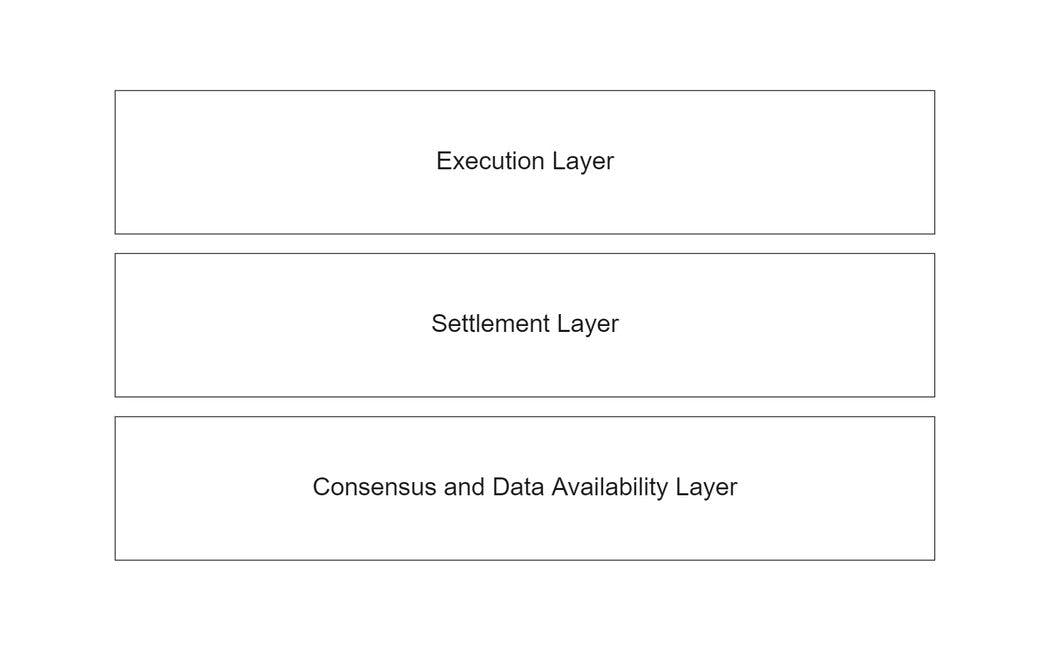
Rollups are an example of a modular blockchain. A rollup chain processes transactions (execution) but outsources consensus, data availability, and settlement to the parent chain. We’ll highlight more examples of modular blockchains in a later section of the article and see how they approach these functions.
A modular chain may often perform two or more functions, especially if they’re interdependent. For example, data availability layers must also reach consensus on the ordering of data, or it becomes impossible to know what data represents the correct version of history.
How does Ethereum work in a modular context?
Like Bitcoin and many first-generation blockchains, Ethereum was designed as a monolithic blockchain. However, to increase scalability and sustainability, the Ethereum network is currently transitioning towards a modular framework. Here’s how Ethereum works in a modular context:
Sharding
Sharding is the process of splitting up a system (e.g., a database) to work in parts. By splitting functions across multiple components, the system achieves more output and efficiency than if all parts were working together on the same duties. In blockchain networks, sharding splits up the blockchain into multiple sub-chains, each handling a different portion of network activity.
Ethereum is adopting a sharded design in which e 64 shard chains will operate in parallel. Shards can process transactions in parallel (execution sharding) or serve as “depots” for storing different chunks of blockchain data (data sharding). Using data sharding, an Ethereum node will only store data published on its shard chain; this is in contrast to its current structure, which requires all nodes to store the same data.
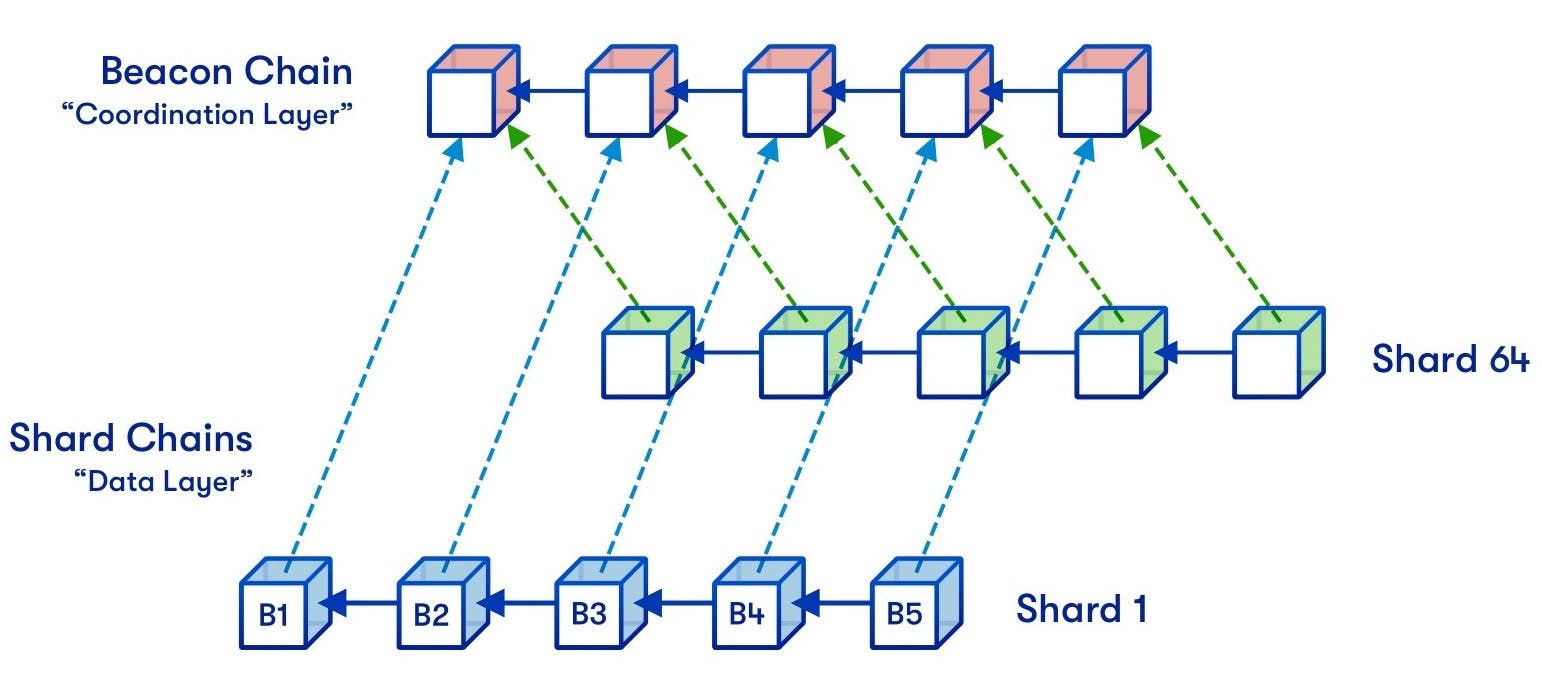
Ethereum sharding is a form of modularity in which different components (shard chains) handle different duties. In data sharding, shard chains store different portions of Ethereum’s data, while execution sharding allows each shard chain to process its own set of transactions, which increases data throughput and shrinks processing times.
Rollups
Some developers have adopted a rollup-centric approach to scaling Ethereum. Unlike pure off-chain scaling solutions, such as sidechains, rollups are tightly coupled with the parent chain. If anything, a rollup is an extension of the main chain designed to scale throughput on the latter.
The Ethereum blockchain outsources computation to rollups while focusing on settlement, consensus, and data availability. Rollups can aggressively optimize for execution by having faster block times and bigger blocks without harming decentralization or security. That’s because Ethereum acts as the base layer (or “Layer 1”) for rollups sitting on Layer 2.
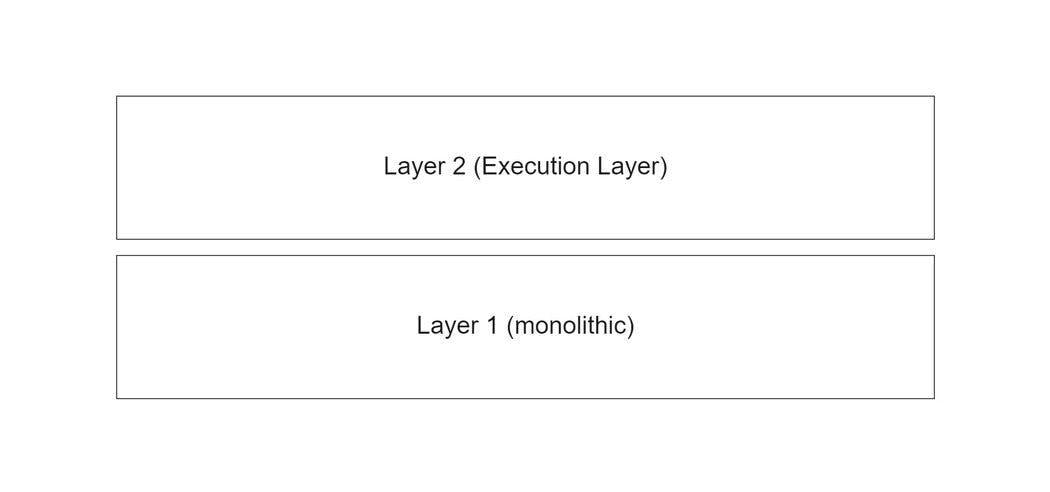
What are the benefits of a modular blockchain design?
Modular blockchain designs offer the following benefits: scalability, flexibility, and the ability to launch new blockchains.
1. Scalability
The blockchain trilemma states that a blockchain can only have two of three possible qualities, but never all three at the same time: decentralization, security, and scalability. Optimizing for certain qualities (scalability) leads to trade-offs in other areas (security and decentralization), which is why scaling blockchains is difficult.
However, scaling difficulties mostly occur when a blockchain tries to handle all activities at once under a single layer. Applying modularity to blockchains (separating tasks between different layers) improves scale without introducing unwholesome trust assumptions.
For example, rollups that focus on execution provide greater scalability than regular chains. Still, they achieve a high degree of security by relying on Ethereum for consensus and data availability.
2. Launching new blockchains
Launching a new blockchain can be difficult owing to the need to build up its security properties. A proof-of-stake chain may need to establish a wide distribution of tokens to avoid centralization risks, while a proof-of-work chain may need to attract miners to prevent a few parties from controlling the network’s hash rate.
But what if developers could focus on the minimum, such as execution, and plug in another modular blockchain component to handle specific tasks, like security? By leveraging modular designs, new blockchains can launch faster without worrying about getting every part of the architecture correctly.
3. Flexibility
Modularity provides flexibility that monolithic chains simply cannot offer. Bitcoin’s focus on decentralization and security automatically rules out scalability, while high-throughput chains often trade off some measure of decentralization and security.
Purpose-built modular chains offer greater flexibility with respect to trade-offs and design implementations. For instance, a modular blockchain system may include modular chains that focus on security and data availability, while others focus on execution. Here’s how both benefit from modular design:
A security and data availability layer benefits from extra scalability since transactions are processed separately. It only needs to enforce the validity of off-chain execution and guarantee the availability of off-chain data. This is how Ethereum’s scalability benefits from using rollups.
An execution layer (which is optimized for scalability) benefits from extra security by leveraging the parent chain’s properties. This is how Layer 2s benefit from Ethereum’s decentralization.
What are the drawbacks of a modular blockchain?
Modular blockchain designs have the following drawbacks: security, complexity, and token value.
1. Security
Unlike monolithic chains, a modular chain cannot guarantee its own security qualities. If the security layer (which usually handles consensus and data availability) isn’t effective, the modular chain risks failure.
2. Complexity
Implementing modular blockchain designs introduces new complexity. For example, Ethereum’s data sharding plan relies on data availability sampling to ensure nodes on one shard don’t withhold data. Similarly, execution layers must require certain complex mechanisms, such as fraud proofs and validity proofs, that allow the security layer to enforce the validity of off-chain state transitions.
3. Token value
Some modular chains may be unable to attract value to their native tokens due to their limited applications. For example, a layer purely focused on consensus and data availability will likely see less use for its utility token compared to an execution layer. It may also be more difficult to attract participants to such networks.
Modular Blockchain Platform Examples
Ethereum
As explained, Ethereum’s reliance on data sharding and rollup-centric computation make it a kind of modular chain. It separates consensus and data availability in the first case and outsources execution in the second.
Celestia and Polygon Avail
Celestia and Polygon Avail are two new modular blockchains primarily concerned with consensus and data availability. Celestia and Polygon Avail nodes are only responsible for storing and ordering transactions; they don't interpret transaction data for execution. It is expected that these chains will serve as data availability layers for other execution layers (e.g., rollups).
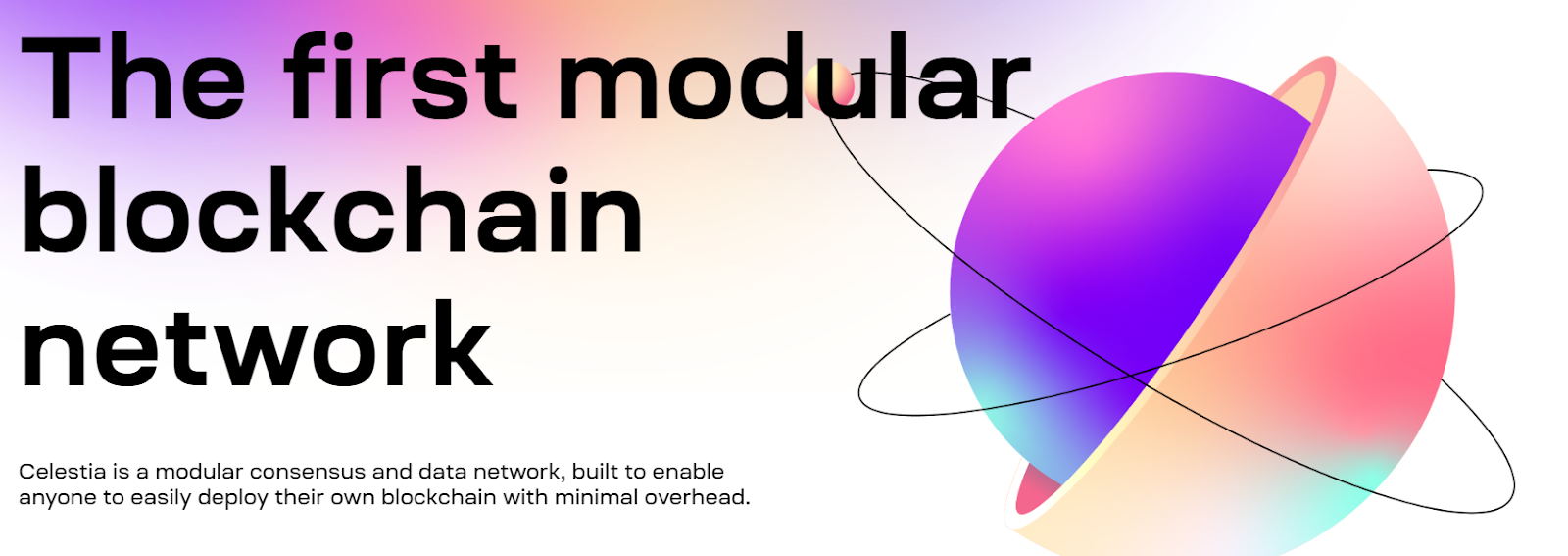
Validiums
A validium is similar to a zero-knowledge rollup: it executes transactions off-chain and submits them (in batches) to a parent chain along with a validity proof. The difference is that a validium chain stores off-chain data elsewhere, not the parent chain. This can be with a data availability committee or a data availability network composed of proof-of-stake validators (Celestia is an example of a PoS-based data availability network)
The validium’s modular stack is as follows:
Execution layer (validium chain)
Settlement and security layer (parent chain)
Data availability and consensus layer (DAC or PoS validator network)
Rollups
As previously described, rollup designs (optimistic rollups and zero-knowledge rollup projects) adopt a modular approach. An optimistic rollup running the Optimistic Virtual Machine or a ZK-rollup running a zkEVM acts as an execution layer (executing smart contracts, processing transactions). However, they rely on Ethereum for other functions:
Data availability and consensus: Rollups publish transaction data to Ethereum Mainnet as CALLDATA. This allows anyone to execute the rollup’s transactions and rebuild its state if necessary.
Settlement: All rollup transactions are finalized on Ethereum. For zero-knowledge rollups, this happens after the zero-knowledge proof is verified. Optimistic rollup users wait until the challenge period elapses or if the transaction is deemed valid after a fraud proof computation.
What is a monolithic blockchain?
“Monolithic” means “formed from a single piece”, which explains its use in describing blockchains that adopt a unified-structure model. A monolithic chain is one in which nodes are responsible for consensus, data availability, and execution. Since transactions are validated on-chain, the monolithic chain also serves as a settlement layer.
How does a monolithic blockchain work?
In a monolithic chain, all tasks are handled on a single layer or a group of tightly-coupled chains operating on the same layer. The latter distinction is important to note: a network of interconnected blockchains that handle all roles, such as Polkadot’s parachains or Avalanche’s subnets, doesn’t qualify as modular architecture.
To understand how a monolithic chain works, we’ll use the Bitcoin protocol as an example:
A Bitcoin node receives a transaction from another peer, verifies the signature, and ensures it satisfies consensus rules.
If the transaction is valid, the node adds it to the mempool (otherwise, it drops the transaction).
A miner takes the transaction from the mempool and adds it to a candidate block.
If the miner succeeds in finding the nonce for the candidate block (as dictated by proof-of-work rules), they can broadcast the block to peers. Other nodes re-execute transactions to ensure validity and, if all is approved, add the new block to the chain.
This process repeats with other miners, eventually increasing the chain by building new blocks on the previously added block.
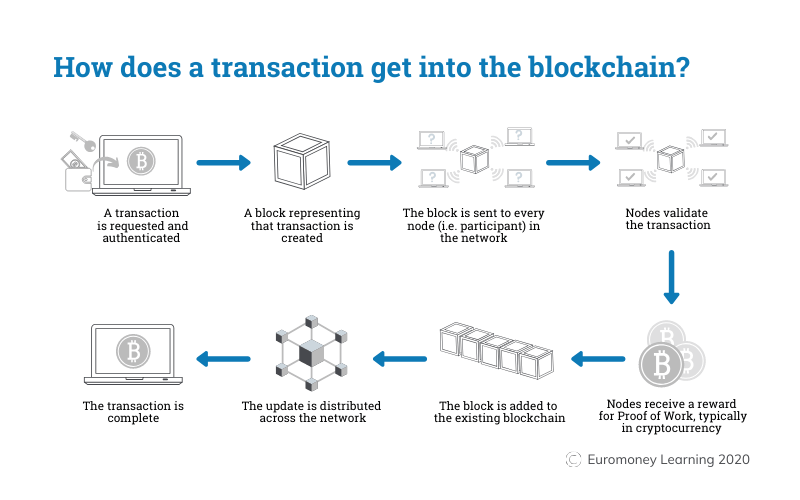
What is a monolithic blockchain architecture?
The previous section describes the workflow for a transaction on a proof-of-work chain, but how does it translate to a monolithic architecture? Here’s a list of things nodes on a monolithic chain do for every transaction:
1. Data availability
Each node holds a copy of the entire blockchain and stores every transaction. A peer can always request transaction data from fellow nodes.
2. Execution
All nodes re-execute transactions to check validity. On an account-based blockchain (usually one that supports smart contracts), nodes execute transactions to compute the new network state.
3. Consensus
The nodes agree on what transactions will be processed for new blocks and the ordering of the transactions they contain
4. Settlement
Settlement requires committing a transaction permanently to the chain’s history. Nodes proposing transactions must place an economic stake against the integrity of blocks. For Proof-of-Work blockchains, this “stake” is the energy expended on mining new blocks, while Proof-of-Stake blockchains require validators to stake tokens on the validity of blocks—these tokens can be confiscated from bad actors who attempt to write false or inaccurate transactions to the chain
A monolithic blockchain architecture requires nodes to perform all of these roles. This is different from a modular chain, which separates execution from settlement, consensus, and data availability.
![A comparison of monolithic and modular blockchain networks. [Source: Celestia]](/_next/image?url=https%3A%2F%2Fwww.datocms-assets.com%2F105223%2F1704285531-monolithic-vs-modular-blockchain.jpeg&w=1920&q=75)
What are the benefits of a monolithic blockchain design?
Monolithic blockchain designs offer the following benefits: security, utility, and simplicity.
1. Security
Monolithic blockchains have the advantage of being able to enforce their own security. Nodes can see transactions executed on-chain and check their validity before reaching consensus. It is also trivial to solve the data availability problem since blockchain data is redundantly stored on multiple nodes.
2. Utility
A monolithic blockchain handling execution in addition to other duties has a better value proposition. With users buying the native token for several uses, it can accrue more value in the long term.
3. Simplicity
Monolithic blockchains are easier to design and implement, as developers have years of experiments in blockchain technology to draw from. Designing secure and efficient modular chains requires a higher level of skill and introduces more considerations to the design process.
What are the drawbacks of a monolithic blockchain?
Monolithic blockchain designs have the following drawbacks: inefficient execution, resource limits, flexibility, scalability, security, and decentralization.
Inefficient execution: Nodes on a monolithic chain have to re-execute transactions to verify validity.
Resource limits: Limits on a node’s resources, such as storage and bandwidth, affect the blockchain’s efficiency.
Flexibility: Monolithic chains are inflexible and cannot optimize for desired qualities without trading off another.
Scalability: To achieve higher throughput, monolithic chains implement faster block times and bigger block sizes. This imposes higher hardware requirements on nodes and reduces the number of those that can validate the chain—leading to centralization and greater security risks.
Security and decentralization: To achieve high decentralization, monolithic blockchains limit block times and block sizes. This increases the number of validating nodes, but having every node process transactions leads to lower throughput.
State bloat: Storing transaction data on-chain leads to exponential growth in the blockchain’s size over time. This can impose higher hardware requirements on nodes and harm decentralization.
Monolithic Blockchain Platform Examples
Bitcoin
Bitcoin is the original monolithic chain, requiring nodes to execute every block against their copy of the blockchain. While this increases decentralization and security, it limits Bitcoin’s ability to support high throughput or scale to accept more users (the Bitcoin blockchain processes 5-7 transactions per second).
Ethereum 1.0
Ethereum, without sharding and rollups, exists as a monolithic chain. This accounts for its slow transaction speeds (15-20 transactions per second) and greater emphasis on decentralization and security.
Solana
Solana is another monolithic chain that handles execution, data availability, and consensus in one location. Unlike Ethereum, Solana optimizes for scalability and has claimed speeds of up to 65,000 transactions per second. These scalability benefits, unsurprisingly, come at the cost of decentralization and security—especially as the hardware requirement to run a validator node is high, with many validators running bare-metal environments rather than cloud infrastructure.
How to Choose: Modular vs. Monolithic Blockchains
Monolithic chains and modular chains both have their benefits and drawbacks. Choosing either option requires understanding your project’s needs and acceptable trade-offs. A high-value DeFi application might opt for a monolithic chain’s security guarantees, while projects that require cheaper and faster operations (e.g., high-frequency trading) may be better suited to a modular chain optimized for execution.
Alchemy offers support for building on monolithic blockchains, including Ethereum, Solana, and Crypto.org. You can also leverage the power of modular blockchains, such as optimistic rollups (e.g. Optimism, Arbitrum) and ZK-rollups/Validium (StarkNet).
Frequently Asked Questions
What is the main difference between modular and monolithic blockchains?
Monolithic blockchains handle all core functions—execution, consensus, data availability, and settlement—on a single layer, while modular blockchains split these duties across specialized layers or chains.
Why are modular blockchains more scalable than monolithic ones?
Modular designs offload tasks like execution to separate layers, allowing each component to be optimized independently and enabling higher throughput without sacrificing decentralization or security on the base layer.
What are the main benefits of using a modular blockchain architecture?
Modular blockchains offer improved scalability, greater flexibility in design trade-offs, and enable faster blockchain launches by allowing developers to focus on specific functions while leveraging existing infrastructure for others.
What are the drawbacks of modular blockchain designs?
Modular blockchains introduce complexity in coordination between layers, cannot guarantee their own security properties, and may have limited token utility compared to monolithic chains.
How does Ethereum function as a modular blockchain?
Ethereum is transitioning to modularity through sharding (splitting data across multiple chains) and a rollup-centric approach where it handles settlement, consensus, and data availability while outsourcing execution to Layer 2 rollups.
What are some examples of modular blockchain platforms?
Examples include Celestia and Polygon Avail (data availability layers), rollups like Optimism and Arbitrum (execution layers), and validiums that separate execution, settlement, and data availability across different layers.
What are the advantages of monolithic blockchain designs?
Monolithic blockchains offer simplicity in design and implementation, can enforce their own security properties, and typically have better token utility since users need the native token for multiple functions.
Is Solana a monolithic or modular blockchain?
Solana is a monolithic blockchain that handles execution, data availability, and consensus in one location, optimizing for scalability with claimed speeds up to 65,000 transactions per second.

Related overviews
Explore the world of L2 blockchains and how this scaling solution is driving onchain innovation.
Learn About Coinbase's New L2 Blockchain, and Determine if its Right For Your dApp
Discover the Reasons Why Developers Choose to Build on Polygon

Build blockchain magic
Alchemy combines the most powerful web3 developer products and tools with resources, community and legendary support.